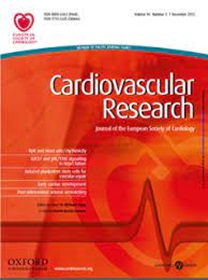CXCR4-targeted sensitive magnetic particle imaging for abdominal aortic aneurysm early detection and prognosis evaluation by recognizing total inflammatory cells
IF 10.2
1区 医学
Q1 CARDIAC & CARDIOVASCULAR SYSTEMS
引用次数: 0
Abstract
Background The maximum aortic diameter remains the diagnostic criteria and the indicator for prognosis prediction of abdominal aortic aneurysms (AAA). An additional imaging modality is currently needed to help evaluate the prognosis of AAA as well as early detection of AAA formation. This study evaluated the most effective inflammatory markers for AAA using single-cell sequencing and, from these, developed probes to facilitate in vivo multimodal imaging of AAA inflammation. Methods and Results Single-cell RNA sequencing (scRNAseq) of the human aortic aneurysms, GSE155468 and GSE166676 datasets, identified CXCR4 as the most representative marker. Anti-CXCR4-PE antibody was conjugated to superparamagnetic iron oxide nanoparticles to synthesise Fe3O4-anti-CXCR4-PE probes. The biocompatibility and specificity of the probes were validated in vivo and in vitro. Magnetic particle imaging (MPI) and fluorescence imaging (FLI) were performed to assess inflammation in early and advanced AAA mouse models. CXCR4-specific receptor inhibitor, AMD3100, was used for confirming CXCR4 as an excellent target for AAA imaging and therapy. scRNAseq indicated that chemokine-related pathways were upregulated in aortic aneurysms, and CXCR4 was the chemokine receptor that markers all AAA-related immune cells and inflammatory vascular cells. Fe3O4-anti-CXCR4-PE effectively recognised immune cells and inflammatory vascular cells, as strong MPI and FLI signals corresponded to increased CXCR4, CD45, and CD68 levels which represented AAA severity and rupture risk. Importantly, Fe3O4-anti-CXCR4-PE can help identify early AAA formation when ultrasound is undiagnosable. Finally, AMD3100 treatment in AAA mouse model inhibited AAA expansion and rupture and reduced aortic wall inflammation by inhibiting accumulation of immune cells and hematopoietic stem cells. Conclusion CXCR4 markers immune cells and inflammatory vascular cells in AAA and is associated with AAA prognosis in a mouse model of AAA. CXCR4-targeting multimodal MPI/FLI provides a novel approach for AAA prognosis prediction and early detection.cxcr4靶向敏感磁颗粒成像识别总炎性细胞在腹主动脉瘤早期发现及预后评价中的应用
背景腹主动脉瘤(AAA)的诊断标准和预后预测指标仍以最大主动脉直径为标准。目前需要一种额外的成像方式来帮助评估AAA的预后以及早期发现AAA的形成。本研究利用单细胞测序评估了AAA最有效的炎症标志物,并由此开发了探针,以促进AAA炎症的体内多模态成像。方法与结果对人主动脉瘤GSE155468和GSE166676数据集进行单细胞RNA测序(scRNAseq),鉴定出CXCR4为最具代表性的标记物。将抗cxcr4 - pe抗体与超顺磁性氧化铁纳米颗粒偶联,合成fe3o4 -抗cxcr4 - pe探针。在体内和体外验证了探针的生物相容性和特异性。采用磁颗粒成像(MPI)和荧光成像(FLI)评估早期和晚期AAA小鼠模型的炎症反应。使用CXCR4特异性受体抑制剂AMD3100证实CXCR4是AAA成像和治疗的优秀靶点。scRNAseq表明趋化因子相关通路在主动脉瘤中上调,而CXCR4是标记所有aaa相关免疫细胞和炎性血管细胞的趋化因子受体。Fe3O4-anti-CXCR4-PE能有效识别免疫细胞和炎性血管细胞,因为MPI和FLI信号较强,对应于CXCR4、CD45和CD68水平升高,代表AAA严重程度和破裂风险。重要的是,Fe3O4-anti-CXCR4-PE可以在超声无法诊断的情况下帮助识别早期AAA形成。最后,在AAA小鼠模型中,AMD3100处理通过抑制免疫细胞和造血干细胞的积累,抑制AAA扩张和破裂,减轻主动脉壁炎症。结论CXCR4在AAA小鼠模型中标记AAA免疫细胞和炎症血管细胞,并与AAA预后相关,CXCR4靶向多模态MPI/FLI为AAA预后预测和早期检测提供了一种新的方法。
本文章由计算机程序翻译,如有差异,请以英文原文为准。
求助全文
约1分钟内获得全文
求助全文
来源期刊

Cardiovascular Research
医学-心血管系统
CiteScore
21.50
自引率
3.70%
发文量
547
审稿时长
1 months
期刊介绍:
Cardiovascular Research
Journal Overview:
International journal of the European Society of Cardiology
Focuses on basic and translational research in cardiology and cardiovascular biology
Aims to enhance insight into cardiovascular disease mechanisms and innovation prospects
Submission Criteria:
Welcomes papers covering molecular, sub-cellular, cellular, organ, and organism levels
Accepts clinical proof-of-concept and translational studies
Manuscripts expected to provide significant contribution to cardiovascular biology and diseases
 求助内容:
求助内容: 应助结果提醒方式:
应助结果提醒方式:


